FILE - In this Nov. 7, 2008 file photo, U.S. Army chaplain Geoffrey Bailey leads soldiers on a tour of St. Elijah's Monastery on Forward Operating Base Marez on the outskirts of Mosul, 360 kilometers (225 miles) northwest of Baghdad, Iraq. The oldest Christian monastery in Iraq, St. Elijahâs stood as a place of worship for 1,400 years. Satellite photos obtained by The Associated Press confirm that the monastery in Iraq has been reduced to a field of rubble, yet another victim of the Islamic State's relentless destruction. (AP Photo/Maya Alleruzzo, File)
The Associated Press
IRBIL, Iraq (AP) - The Obama Administration and the Vatican condemned the Islamic State group Wednesday for razing Iraq's oldest Christian monastery, a 1400-year-old structure that survived assaults by nature and man for centuries before it was deliberately destroyed by extremists.
At the United Nations, UNESCO Director General Irina Bokova said reducing St. Elijah's monastery in Mosul to a field of rubble was malicious and misguided. The Associated Press confirmed the news with exclusive satellite images published early Wednesday.
"Despite their relentless crimes, extremists will never be able to erase history," said Bokova, who called the demolition a war crime. "It also reminds us how terrified by history the extremists are, because understanding the past undermines the pretexts they use to justify these crimes and exposes them as expressions of pure hatred and ignorance."
St. Elijah's monastery on the outskirts of Mosul was a place of worship recently for U.S. troops, who worked to restore it. In earlier centuries, generations of monks tucked candles in the niches and prayed in the cool chapel. The Greek letters chi and rho, representing the first two letters of Christ's name, were carved near the entrance.
During a press briefing in Washington on Wednesday, State Department spokesman Mark Toner said the Obama Administration condemned the destruction by IS. "They continue to carry out these kinds of depraved acts, and it really symbolizes or exemplifies their bankrupt ideology," he said.
In his office in exile in Irbil, Iraq, the Rev. Paul Thabit Habib, 39, stared quietly at before- and after-images of the monastery that once perched on a hillside above his hometown of Mosul. Shaken, he flipped back to his own photos for comparison.
"I can't describe my sadness," he said in Arabic. "Our Christian history in Mosul is being barbarically leveled. We see it as an attempt to expel us from Iraq, eliminating and finishing our existence in this land."
The Islamic State group, which broke from al-Qaida and now controls large parts of Iraq and Syria, has killed thousands of civilians and forced out hundreds of thousands of Christians, threatening a religion that has endured in the region for 2,000 years. Along the way, its fighters have destroyed buildings and ruined historical and culturally significant structures they consider contrary to their interpretation of Islam.
Those who knew the monastery wondered about its fate after the extremists swept through in June 2014 and largely cut communications to the area.
Now, St. Elijah's has joined a growing list of more than 100 demolished religious and historic sites, including mosques, tombs, shrines and churches in Syria and Iraq. The extremists have defaced or ruined ancient monuments in Nineveh, Palmyra and Hatra. Museums and libraries have been looted, books burned, artwork crushed - or trafficked.
"A big part of tangible history has been destroyed," said Rev. Manuel Yousif Boji. A Chaldean Catholic pastor in Southfield, Michigan, he remembers attending Mass at St. Elijah's almost 60 years ago while a seminarian in Mosul.
"These persecutions have happened to our church more than once, but we believe in the power of truth, the power of God," said Boji. He is part of the Detroit area's Chaldean community, which became the largest outside Iraq after the sectarian bloodshed that followed the U.S. invasion in 2003. Iraq's Christian population has dropped from 1.3 million then to 300,000 now, church authorities say.
At the Vatican, spokesman Rev. Federico Lombardi noted that since the monastery dates back to the time Christians were united, the place would be a special one for many. He said it was the first news he had had of the destruction.
"Unfortunately, there is this systemic destruction of precious sites, not only cultural, but also religious and spiritual. It's very sad and dramatic," Lombardi said.
The loss of the monastery is a blow for U.S. troops and advisers who served in Iraq and had tried to protect and honor the site, a hopeful endeavor in a violent place and time.
Suzanne Bott, who spent more than two years restoring St. Elijah's Monastery as a U.S. State Department cultural adviser in Iraq, teared up when the AP showed her the images.
"Oh no way. It's just razed completely," said Bott. "What we lose is a very tangible reminder of the roots of a religion. Now it's gone."
Army reserve Col. Mary Prophit remembered a sunrise service in St. Elijah where, as a Catholic lay minister, she served communion.
"I let that moment sink in, the candlelight, the first rays of sunshine. We were worshipping in a place where people had been worshipping God for 1,400 years," said Prophit, who was deployed there in 2004 and again in 2009.
"I would imagine that many people are feeling like, 'What were the last 10 years for if these guys can go in and destroy everything?'" said Prophit, a library manager in Glenoma, Washington.
This month, at the request of AP, satellite imagery firm DigitalGlobe pulled a series of images of the same spot from their archive of pictures taken globally every day.
Imagery analyst Stephen Wood, CEO of Allsource Analysis, reviewed the pictures for AP and identified the date of destruction between Aug. 27 and Sept. 28, 2014. Before it was razed, images show a partially restored, 27,000-square-foot religious building. Although the roof was largely missing, it had 26 distinctive rooms including a sanctuary and chapel. One month later, "the stone walls have been literally pulverized," said Wood.
"Bulldozers, heavy equipment, sledgehammers, possibly explosives turned those stone walls into this field of gray-white dust," he said. "There's nothing to rebuild."
Congressman Eliot Engel, the top Democrat on the House Foreign Affairs committee who authored legislation to crack down on the Islamic State group's trafficking of looted artifacts, called the destruction "just another tragic step in the slow disappearance of that population and another brutal abuse by ISIS.
"It's sickening to see ISIS terrorists try to wipe away history and pocket millions by trafficking artifacts looted from these sites, resources they are using to support their campaign of terror," he said.
The monastery, called Dair Mar Elia, is named for the Assyrian Christian monk - St. Elijah - who built it between 582 and 590 A.C. It was a holy site for Iraqi Christians for centuries, part of the Mideast's Chaldean Catholic community.
In 1743, tragedy struck when as many as 150 monks who refused to convert to Islam were massacred under orders of a Persian general, and the monastery was damaged. For the next two centuries it remained a place of pilgrimage, even after it was incorporated into an Iraqi military training base and later a U.S. base.
Then in 2003 St. Elijah's shuddered again - this time a wall was smashed by a tank turret blown off in battle. Iraqi troops had already moved in, dumping garbage in the ancient cistern. The U.S. Army's 101st Airborne Division took control, with troops painting over ancient murals and scrawling their division's "Screaming Eagle," along with "Chad wuz here" and "I love Debbie," on the walls.
A U.S. military chaplain, recognizing St. Elijah's significance, kicked the troops out and the Army's subsequent preservation initiative became a pet project for a series of chaplains who toured thousands of soldiers through the ruin.
"It was a sacred place. We literally bent down physically to enter, an acquiescence to the reality that there was something greater going on inside," remembered military chaplain Jeffrey Whorton. A Catholic priest who now works at Ft. Bragg, he had to collect himself after viewing the damage. "I don't know why this is affecting me so much," he said.
The U.S. military's efforts drew attention from international media outlets including the AP in 2008. Today those chronicles, from YouTube videos captured on the cell phones of visiting soldiers to AP's own high resolution, detailed photographs, take on new importance as archives of what was lost.
One piece published in Smithsonian Magazine was written by American journalist James Foley, six years before he was killed by Islamic State militants.
St. Elijah's was being saved, Foley wrote in 2008, "for future generations of Iraqis who will hopefully soon have the security to appreciate it."
___
Mendoza reported from Santa Cruz, Calif. Alleruzzo reported from Cairo. Associated Press writer Frances D'Emilio contributed to this report from Rome.
___
Follow AP journalists on Twitter @mendozamartha; @mayaalleruzzo and @bramjanssen
This combination of two satellite images provided by DigitalGlobe, taken on March 31, 2011, top, and Sept. 28, 2014, shows the site of the 1,400-year-old Christian monastery known as St. Elijahâs, or Dair Mar Elia, on the outskirts of Mosul, Iraq. These satellite photos obtained by The Associated Press in January 2016 confirm what church leaders and Middle East preservationists had feared: The monastery has been reduced to a field of rubble, yet another victim of the Islamic State's relentless destruction. (DigitalGlobe via AP)
The Associated Press
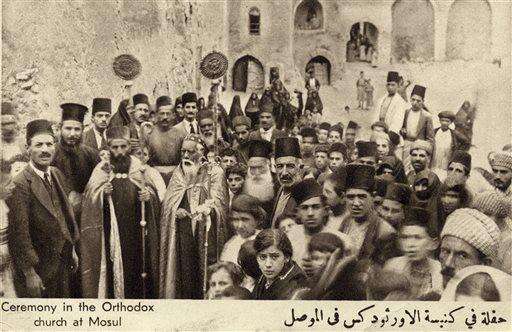
This photo taken in the 1920s shows a ceremony at the Mar Matai monastery in Mosul, Iraq, where a Christian community thrived for centuries. Satellite photos obtained by The Associated Press in January 2016 confirm the communityâs oldest place of worship, the 1,400-year-old St. Elijahâs Monastery, has been reduced to a field of rubble, yet another victim of the Islamic State's relentless destruction. (Otrakji family collection on mideastimage.com via AP)
The Associated Press
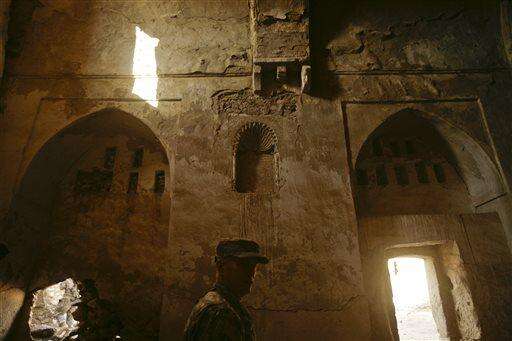
In this Nov. 7, 2008, photo, U.S. Army soldiers tour St. Elijah's Monastery on Forward Operating Base Marez on the outskirts of Mosul, Iraq. Maj. Geoffrey Bailey, now a US Army command chaplain in Kabul, Afghanistan, who led prayers and tours at St. Elijahâs, said news of the destruction of the monastery by militants was âincredibly disappointing. In the midst of the strife and suffering of combat, a symbol of hope set against the verdant hills of Mosul sprang forth and provided a momentary respite for weary sojourners, much like it had for...centuries prior.â (AP Photo/Maya Alleruzzo)
The Associated Press
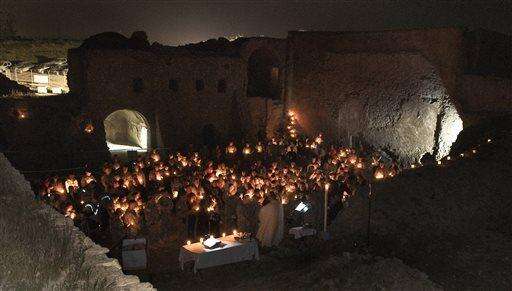
In this April 3, 2010, photo released by the U.S. Army, soldiers celebrate a Catholic Easter mass at St. Elijah's Monastery on the outskirts of Mosul, Iraq. Before it was razed, the partially restored, 27,000-square-foot stone and mortar building stood fortress-like on a hill above Mosul. Although the roof was largely missing, it had 26 distinctive rooms including a sanctuary and chapel. Satellite photos taken after its destruction show âthat the stone walls have been literally pulverized,â said imagery analyst Stephen Wood, CEO of Allsource Analysis, who pinpointed the destruction between August and September 2014. (Staff Sgt. Russell Lee Klika/U.S. Army via AP)
The Associated Press
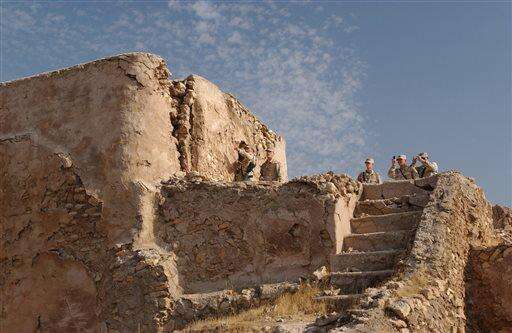
In this Dec. 7, 2005, photo released by the U.S. Army, soldiers can see the city of Mosul, Iraq, from the top of the stairwell at St. Elijahâs Monastery during a visit arranged by Capt. John P. Smith, a chaplain with the 142nd Corps Support Battalion. U.S. troops and advisers had worked to protect and honor the monastery situated on a Forward Operating Base, a hopeful endeavor in a violent place and time. (Sgt. Mitch Armbruster/U.S. Army via AP)
The Associated Press
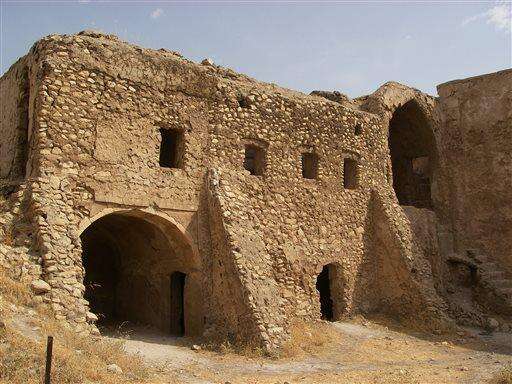
This Oct. 1, 2006, photo provided by the U.S. Army Col. Juanita Chang shows St. Elijah's Monastery on the outskirts of Mosul, Iraq. This month, at the request of AP, satellite imagery firm DigitalGlobe tasked a high resolution camera passing over the site to grab photos, and then pulled earlier images of the same spot from their vast archive of pictures. Imagery analyst Stephen Wood, CEO of Allsource Analysis, confirmed that the monastery is has been completely destroyed and identified the date of destruction between Aug. 27 and Sept. 28, 2014. (Col. Juanita Chang/U.S. Army via AP)
The Associated Press
This March 26, 2005, photo provided by U.S. Army reserve Col. Mary Prophit shows U.S. service members during a sunrise Easter Mass at St. Elijah's Monastery, or Dair Mar Elia, in Mosul, Iraq. For 1,400 years the compound survived assaults by nature and man, standing as a place of worship most recently for U.S. troops. (Col. Mary Prophit/U.S. Army via AP)
The Associated Press
In this April 3, 2010, photo released by the U.S. Army, soldiers celebrate a Catholic Easter Mass at St. Elijah's Monastery on the outskirts of Mosul, Iraq. Satellite photos obtained by The Associated Press confirm the worst fears of church authorities and preservationists: Iraq's oldest Christian monastery has been completely wiped out since the takeover of Mosul by the Islamic State group. (Sgt. Shannon R. Gregory/U.S. Army via AP)
The Associated Press
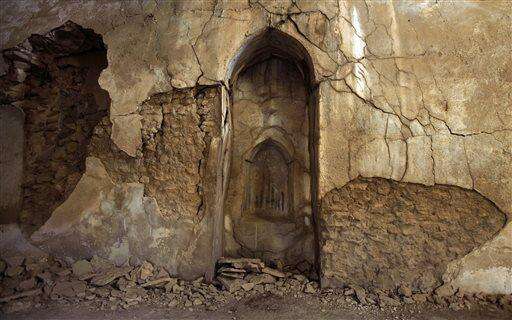
FILE - This Nov. 7, 2008, file photo shows the sanctuary of St. Elijah's Monastery on Forward Operating Base Marez in Mosul, Iraq, about 360 kilometers (225 miles) northwest of Baghdad. Maj. Geoffrey Bailey, now a U.S. Army command chaplain in Kabul, Afghanistan, who led prayers and tours at St. Elijahâs, said the monastery "provided troops a historical glimpse into the great history of Iraq and a chance to indirectly connect with the people who make the country culturally and sociologically rich and worth fighting for.â (AP Photo/Maya Alleruzzo, File)
The Associated Press
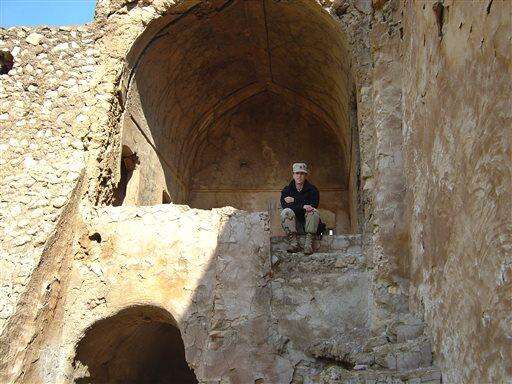
This Nov. 27, 2004, photo provided by U.S. Army reserve Col. Mary Prophit, shows Prophit, then a Major, at St. Elijah's Monastery in Mosul, Iraq. A library manager in Glenoma, Wash., Prophit remembered a sunrise service in St. Elijahâs where, as a Catholic lay minister, she was able to serve communion. âI let that moment sink in, the candlelight, the first rays of sunshine. We were worshipping in a place where people had been worshipping God for 1,400 years,â she said. âIt gives me goosebumps right now.â (Courtesy of Col. Mary Prophit/U.S. Army via AP)
The Associated Press
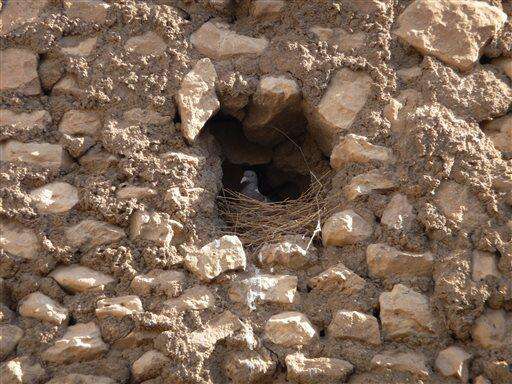
In this Aug. 19, 2009, photo provided by U.S. Army reserve Col. Mary Prophit, a bird nests in the ruins of St. Elijahâs Monastery, or Dair Mar Elia, near Mosul in northern Iraq. St. Elijahâs served as a center of the regional Christian community for centuries, attracting worshippers from throughout the region to pray with the priests who lived there. Tragedy struck in 1743, when as many as 150 monks were massacred by a Persian general because they refused orders to convert to Islam. For the next two centuries, partially damaged, it remained a place of pilgrimage, even after it was incorporated into an Iraqi and then a U.S. military base. (Col. Mary Prophit/U.S. Army via AP)
The Associated Press
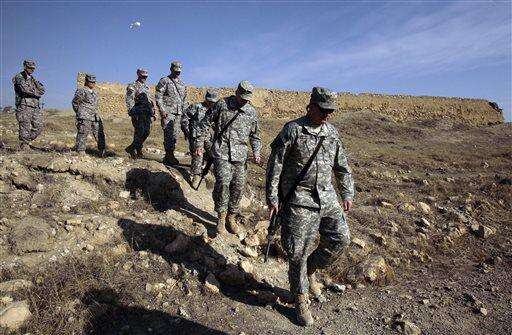
FILE - In this Nov. 7, 2008, file photo, U.S. Army soldiers tour St. Elijah's Monastery on Forward Operating Base Marez in Mosul, Iraq, about 360 kilometers (225 miles) northwest of Baghdad. St. Elijahâs has officially joined a growing list of more than 100 demolished religious and historic sites, including mosques, tombs, shrines and churches. The Islamic State group has defaced or ruined ancient monuments in Nineveh, Palmyra and Hatra. Museums and libraries have been looted, books burned, artwork crushed. (AP Photo/Maya Alleruzzo, File)
The Associated Press
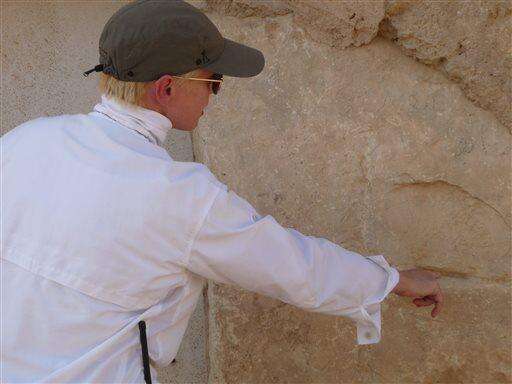
In this Aug. 19, 2009, photo provided by U.S. Army reserve Col. Mary Prophit, Suzanne Bott leads a tour at St. Elijah's Monastery, or Dair Mar Elia, in Mosul, Iraq. Bott spent more than two years surveying and restoring the site as a U.S. State Department cultural adviser in Iraq. Verifying images for the AP that show the destruction of the monastery, the University of Arizona heritage conservationist was quiet for a moment. âThatâs it. Itâs gone,â said Bott. (Col. Mary Prophit via AP)
The Associated Press
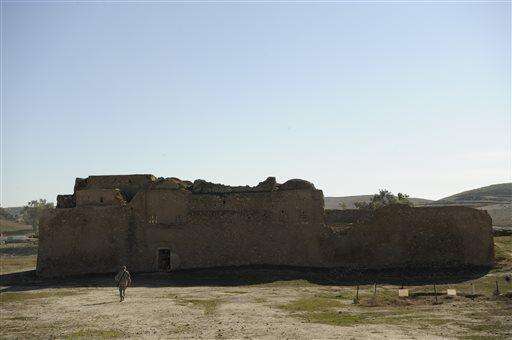
In this Jan. 21, 2009, photo released by the U.S. Department of Defense, a soldier walks toward St. Elijahâs Monastery at Forward Operating Base Marez in Mosul, Iraq. The Islamic State group, which broke from al-Qaida and now controls large parts of Iraq and Syria, has killed thousands of civilians and forced out hundreds of thousands of Christians, threatening a religion that has endured in the region for 2,000 years. Along the way, its fighters destroy anything they consider contrary to their interpretation of Islam. (JoAnn Makinano/Department of Defense via AP)
The Associated Press
In this Aug. 19, 2009, photo provided by US Army reserve Col. Mary Prophit, Suzanne Bott leads a tour at St. Elijah's monastery, or Dair Mar Elia, in Mosul, Iraq. Bott spent more than two years surveying and restoring the site as a U.S. State Department cultural adviser in Iraq. (Col. Mary Prophit via AP)
The Associated Press
In this Aug. 21, 2009, photo released by the U.S. Army, visitors assigned to the Logistic Civil Augmentive Program from Forward Operating Base Speicher, near Tikrit, Iraq, stand at the entrance to the ruins of St. Elijahâs Monastery after completing a tour there, at Forward Operating Base Marez in Mosul, Iraq. The 1,400-year-old monastery has been reduced to a field of rubble, yet another victim of the Islamic State's relentless destruction. (MC1 (SCW) Carmichael Yepez/U.S. Army via AP)
The Associated Press
In this Aug. 19, 2009, photo provided by U.S. Army reserve Col. Mary Prophit, a soldier walks inside St. Elijah's Monastery in Mosul, Iraq. Satellite photos obtained by The Associated Press confirm what church leaders and Middle East preservationists had feared: St. Elijah's, a 1,400-year-old monastery in Iraq, has been reduced to a field of rubble, yet another victim of the Islamic State's relentless destruction. (Col. Mary Prophit/U.S. Army via AP)
The Associated Press
This Nov. 7, 2008, photo shows St. Elijah's Monastery on the outskirts of Mosul, Iraq, about 360 kilometers (225 miles) northwest of Baghdad. St. Elijahâs served as a center of the regional Christian community for centuries, attracting worshippers from throughout the region to pray with its priests. (AP Photo/Maya Alleruzzo)
The Associated Press
In this Nov. 7, 2008, photo, a U.S. Army chaplain gestures toward the place where the 101st Airborne Division's "screaming eagle" was painted above a door at St. Elijah's Monastery on Forward Operating Base Marez in Mosul, Iraq. The chaplain, recognizing the siteâs historical and cultural significance, kicked the troops out and the U.S. Army began a preservation initiative that became a pet project for a series of chaplains who led thousands of soldiers on tours through its weathered walls. (AP Photo/Maya Alleruzzo)
The Associated Press
In this Nov. 7, 2008 photo, U.S. Army soldiers tour St. Elijah's Monastery on Forward Operating Base Marez in Mosul, Iraq. âIt was a sacred place. We literally bent down physically to enter, an acquiescence to the reality that there was something greater going on inside,â remembered military chaplain Jeffrey Whorton. (AP Photo/Maya Alleruzzo)
The Associated Press